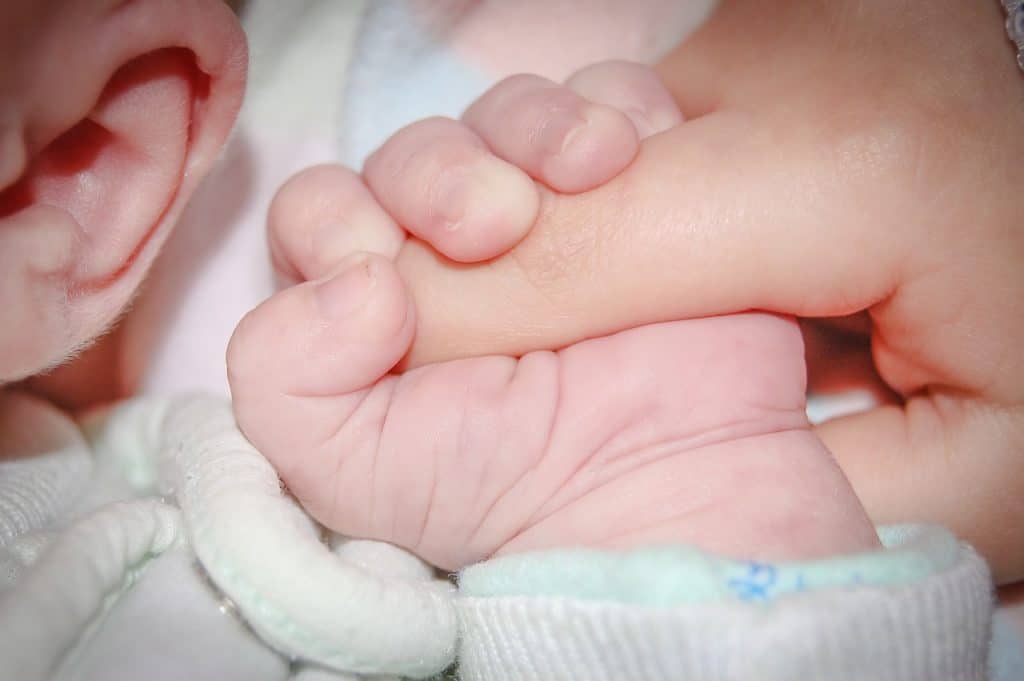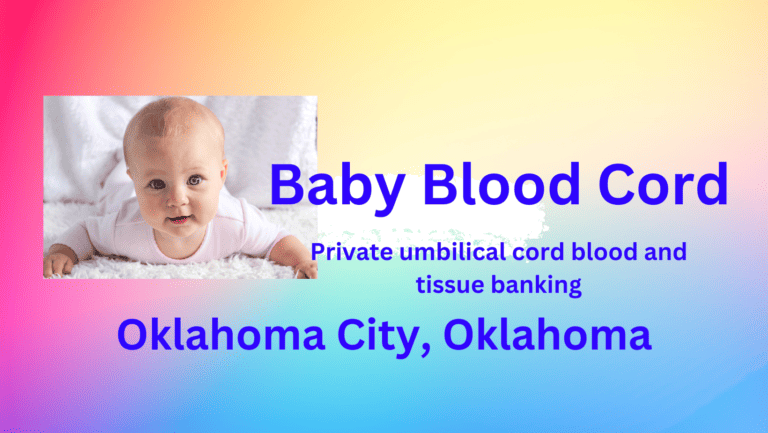
CORD BLOOD BANKING IN OKLAHOMA CITY, OKLAHOMA
What is Cord Blood banking in Oklahoma City, Oklahoma?
Cord blood banking is a procedure that has been gaining increased attention in the medical world for its potential to help treat a range of diseases and medical conditions.
In simple terms, cord blood banking involves collecting and storing stem cells from a newborn’s umbilical cord. These stem cells are rich in potential and can be used to help treat a range of illnesses, including certain cancers, blood disorders, and genetic diseases. As a result, many expectant parents are now considering cord blood banking as a way to secure their child’s health for the future.
The process of banking umbilical cord blood involves collecting the blood immediately after birth and sending it to a specialized facility for processing and storage.
The cost of storage can vary depending on the service provider and the length of storage time chosen. There are many factors to consider when deciding whether to bank cord blood, including family medical history and the potential future use of the stem cells.
What is cord and tissue banking in Oklahoma City, Oklahoma?
Cord tissue banking involves the collection and storage of the cord tissue, which is the gel-like material that surrounds the blood vessels in the umbilical cord. This tissue is rich in stem cells, which are the building blocks of the body’s immune and blood systems. The stem cells found in cord tissue are different from those found in cord blood, making it a valuable resource for future treatments.O
Umbilical cord blood and tissue collection in Oklahoma City, Oklahoma
Umbilical cord blood and tissue are collected immediately after birth via a non-invasive and pain-free procedure.
The umbilical cord is clamped and cut as usual, but instead of discarding the placenta and umbilical cord, they are collected by a trained healthcare professional.
The blood is extracted from the cord using a sterile needle and collected into a specialized bag with anticoagulants to prevent clotting. The tissue is collected by cutting a small piece of the cord and placing it into a sterile container.
Both cord blood and tissue are then transported to a laboratory for processing and storage.
This procedure is a safe and effective way to collect valuable stem cells that can be used for future medical treatments.


Umbilical cord blood and tissue storage near Oklahoma City, Oklahoma
Umbilical cord blood and tissue are valuable sources of stem cells, which have the potential to treat a wide range of diseases.
To ensure the preservation of these stem cells, they are collected at the time of birth and stored in specialized facilities.
The most common method of storage is cryopreservation, where the stem cells are slowly frozen and stored in liquid nitrogen at -196°C.
This ensures that the stem cells can be retrieved and used for medical purposes for many years to come. Additionally, many cord blood banks also offer the option to store the umbilical cord tissue, which contains a different type of stem cell that can also be used for medical treatments.
Overall, proper storage of umbilical cord blood and tissue is crucial for their potential use in future medical treatments.
Oklahoma city, OK
Oklahoma City, the state capital of Oklahoma, is a thriving metropolis located in the heart of the state. Rich in history and culture, Oklahoma City offers a unique blend of western heritage and modern amenities. From its bustling downtown to its vast outdoor recreational areas, Oklahoma City has something to offer for everyone.
Home to over 650,000 residents, Oklahoma City is the largest city in the state. With a growing economy, diverse population, and a strong sense of community, it is no surprise that Oklahoma City has been named one of the best places to live in the country.
In this blog post, we will explore the many facets of Oklahoma City, from its iconic landmarks and attractions to its vibrant arts and culture scene. We will delve into the city’s rich history and take a closer look at how it has evolved into the dynamic city it is today. From Bricktown to the Oklahoma City National Memorial and Museum, we will showcase some of the city’s top destinations that are
1. Vibrant city with rich history.
Oklahoma City, Oklahoma is a vibrant city with a rich history, making it an ideal destination for both business and leisure travelers. Founded in 1889 during the Land Run, Oklahoma City has since grown into a thriving metropolis that offers a unique blend of modern amenities and historical charm. Visitors can explore the city’s rich cultural heritage at the National Cowboy & Western Heritage Museum, which boasts an impressive collection of Western art and artifacts, or at the Oklahoma City National Memorial & Museum, which honors the victims and survivors of the 1995 Oklahoma City bombing. Additionally, the city’s downtown area is home to a lively arts and entertainment district that includes the Chesapeake Energy Arena, the Myriad Botanical Gardens, and the Oklahoma City Museum of Art. With its diverse array of attractions and its warm, welcoming spirit, Oklahoma City is a must-visit destination for anyone seeking an authentic American experience.
2. Home to major sports teams.
Oklahoma City, Oklahoma is a city that boasts a rich sports culture, with several major sports teams calling this city home. The city is home to the NBA team, the Oklahoma City Thunder, which has a strong fan base and has made several playoff appearances. Additionally, the city has a minor league baseball team, the Oklahoma City Dodgers, which is affiliated with the Los Angeles Dodgers. The city also has a USL Championship soccer team, OKC Energy FC, which has been competing since 2014. With a strong passion for sports, Oklahoma City is a destination for sports enthusiasts and fans alike.
3. Boasts a thriving arts scene.
Oklahoma City, Oklahoma boasts a thriving arts scene that is not to be missed. From the Oklahoma City Museum of Art, which features a collection of over 5,000 pieces of art from around the world, to the Civic Center Music Hall, which hosts performances by the Oklahoma City Ballet, the Oklahoma City Philharmonic, and other notable musical acts, there is something for everyone to enjoy. Additionally, the Paseo Arts District is home to over 20 galleries and studios where visitors can explore and purchase artwork from local artists. The city’s thriving arts scene also includes a number of festivals throughout the year, such as the Oklahoma City Arts Festival and the deadCenter Film Festival, showcasing the best of film, music, and visual art from around the world. With all of these offerings, it’s no wonder that Oklahoma City, Oklahoma has become a destination for art lovers everywhere.
4. World-class museums and galleries.
Oklahoma City, Oklahoma is home to many world-class museums and galleries that are worth exploring. One of the most notable institutions is the Oklahoma City Museum of Art, which boasts an impressive collection of over 15,000 works of art from all over the world. The museum’s permanent collection includes works by renowned artists such as Dale Chihuly, Vincent van Gogh, and Georgia O’Keeffe. It also hosts rotating exhibitions and events throughout the year, making it a must-see destination for art enthusiasts. Additionally, the National Cowboy and Western Heritage Museum showcases the history and culture of the American West through a variety of exhibits and artifacts. Visitors can explore the museum’s galleries, which include over 28,000 pieces of Western art and artifacts. The Oklahoma City National Memorial & Museum is another must-visit attraction, which offers a poignant and powerful tribute to the victims of the 1995 Oklahoma City bombing. Overall, Oklahoma City’s world-class museums and galleries provide a rich and diverse cultural experience for locals and visitors alike.
5. Delicious dining options abound.
Oklahoma City, Oklahoma is a vibrant and diverse city that offers a wide range of dining options to its residents and visitors. From traditional Southern cuisine to international flavors, there is something for everyone to enjoy. The city has a thriving restaurant scene with many hidden gems waiting to be discovered. Delicious dining options abound in Oklahoma City, from upscale dining experiences to casual family-friendly eateries. Some of the most popular restaurants in the city offer unique menus featuring local ingredients and regional specialties. Food enthusiasts can explore the city’s food trucks, farmer’s markets, and specialty food shops to discover new and exciting flavors. Overall, Oklahoma City is a food lover’s paradise, with a variety of delicious dining options to satisfy any craving.
6. Plenty of outdoor recreation activities.
Oklahoma City, Oklahoma offers plenty of outdoor recreation activities for both residents and visitors to enjoy. With the city’s beautiful parks and lakes, there are endless opportunities for outdoor adventures. One of the most popular parks in the city is the Myriad Botanical Gardens, which features stunning gardens, a children’s garden, and a playground. Lake Hefner is another popular spot that offers fishing, boating, and jogging trails. For those looking for a more rugged outdoor experience, the Wichita Mountains Wildlife Refuge is a must-visit destination. The refuge covers over 59,000 acres and offers hiking trails, rock climbing, and wildlife viewing opportunities. Overall, Oklahoma City’s ample supply of outdoor recreation activities make it an ideal location for nature enthusiasts and those seeking to explore the outdoors.
7. Affordable cost of living.
Oklahoma City, Oklahoma, is known for its affordable cost of living, making it an attractive destination for individuals and families looking for a comfortable lifestyle without breaking the bank. Compared to other metropolitan areas in the United States, Oklahoma City’s cost of living is significantly lower, with affordable housing options, low taxes, and lower utility costs. This makes it easier to budget and save money, which is especially important for those just starting out in their careers or who are on a fixed income. In addition to the lower cost of living, Oklahoma City also offers a wide range of amenities, including cultural attractions, outdoor recreation, and a thriving job market, making it an excellent choice for those looking for a high quality of life without the high price tag.
8. Growing job market and economy.
Oklahoma City, Oklahoma, has experienced a growing job market and economy in recent years. The city has become a hub for industries such as energy, healthcare, and aerospace, among others. Oklahoma City has also seen a significant increase in job opportunities in the technology sector, with companies like Paycom and Love’s Travel Stops & Country Stores expanding their operations in the city. Additionally, the city’s low cost of living and business-friendly environment have attracted many entrepreneurs and startups, contributing to the city’s economic growth. With a diverse range of industries and a growing job market, Oklahoma City offers many opportunities for job seekers and businesses alike.
9. Diverse and friendly community.
One of the notable features of Oklahoma City is its diverse and friendly community. This city is home to people from various cultures and backgrounds, creating a welcoming environment where everyone feels included. The community celebrates this diversity through numerous events and festivals, such as the Asian Festival, the Latino Festival, and the Juneteenth celebration. Additionally, Oklahoma City has various organizations that promote diversity and inclusion, such as the Oklahoma City Human Rights Commission and the Oklahoma City Black Chamber of Commerce. These groups work together to ensure that everyone feels valued and respected in the community. Overall, the diverse and friendly community in Oklahoma City is one of the city’s greatest strengths, contributing to its vibrant and welcoming atmosphere.
10.umbilical cord blood and tissue banking
Oklahoma City, Oklahoma is among many cities where umbilical cord blood and tissue banking is becoming increasingly popular. The process involves collecting and storing stem cells from the umbilical cord and placenta, which can potentially be used to treat a variety of diseases and conditions, such as leukemia, sickle cell anemia, and lymphoma. Cord blood and tissue banking is a valuable investment in the health of a newborn and their family, as it provides a unique opportunity to store stem cells that may be useful for future medical treatments. The process involves collecting samples from the umbilical cord immediately after birth and sending them to a cord blood bank for storage. This practice has been around for several decades and has proven to be a safe and effective way to store valuable stem cells for future medical use.
In conclusion, Oklahoma City is a thriving city with a rich history and culture. From its Western heritage to its modern-day attractions, there is something for everyone in this city. Its booming economy, affordable cost of living, and friendly community make it an attractive destination for individuals and families alike. As the city continues to grow and evolve, it is poised to become an even more prominent player in the national stage. Whether you are a resident or a visitor, Oklahoma City is a city worth exploring.

Stem cells, umbilical cord blood and tissue collection in Oklahoma City, Oklahoma
The Day I Discovered Gold in the Umbilical Cord: A Scientist’s Memoir
They called it medical waste. Back in the late 1980s, that’s all the umbilical cord was. A discarded byproduct of the miracle of birth. But I saw something else. Or rather—I almost didn’t.
My name is Dr. Evan Harrow. I’ve spent the better part of my career studying blood, stem cells, and the regenerative potential locked deep inside the human body. But it wasn’t until one ordinary afternoon in the pathology lab, surrounded by specimens no one else wanted, that I stumbled onto what would become the most meaningful discovery of my life.
Umbilical cord blood and tissue storage near Oklahoma City, Oklahoma
A Forgotten Sample
It was a Friday. A resident had left a sealed container labeled “cord blood” on my desk by mistake. I was supposed to analyze a bone marrow aspirate. Annoyed, I popped open the file, intending to toss it aside—and then I saw it.
The cell counts were… astonishing. High concentrations of what looked like primitive hematopoietic cells—the very precursors of immune cells, red cells, and platelets. Cells that weren’t yet committed to a path. Cells with promise.
“Where did this come from?” I asked.
“The delivery floor,” the nurse said. “Just cord blood. You know, waste.”
Waste.
I ran to the microscope. Then flow cytometry. I tested for cell surface markers. CD34+ expression? Off the charts. Colony-forming ability? Robust. These weren’t ordinary cells. These were stem cells—young, powerful, and pure.
That night, I didn’t sleep.
CORD BLOOD REGISTRY IN OKLAHOMA CITY, OKLAHOMA
A Revolution Nobody Saw Coming
We knew that bone marrow transplants could save lives. Children with leukemia. Adults with blood disorders. But they required a donor match. They were invasive, painful, and often hard to come by.
But this? Cord blood? It was non-invasive, abundant, and immediately available. What’s more—cord blood stem cells had immature immune systems, making them more tolerant of mismatched transplants.
It was the perfect material for hematopoietic stem cell transplants—and no one was using it.
I published my first paper that year. The skepticism was immediate.
“You want to use what?”
“It’s not enough volume.”
“Too risky.”
“No clinical precedent.”
But the science couldn’t be ignored. A year later, in Paris, the first successful cord blood transplant saved a little boy with Fanconi anemia. The donor? His newborn sister.
The floodgates opened.
What is Cord Blood banking in Oklahoma City, Oklahoma
?
From Labs to Lives
Since then, tens of thousands of cord blood transplants have been performed. For diseases like leukemia, sickle cell anemia, lymphomas, thalassemia, and more. Families who once faced hopeless diagnoses now had a shot—sometimes, thanks to a decision made at birth.
And that was just the beginning.
With time, the focus turned to cord tissue, which contains mesenchymal stem cells (MSCs). These cells have the power to regenerate bone, cartilage, muscle, and even nerves. Clinical trials are now exploring their use in treating autism, cerebral palsy, spinal cord injuries, and heart disease.
We used to think healing came from the outside. Now, we know it can come from within.
The Moment Parents Become Scientists
I’ve spoken with hundreds of families over the years. Some chose to privately bank their child’s cord blood. Others donated it to public registries. Some didn’t even know it was an option and later regretted it.
But what strikes me every time is the look in their eyes when they realize what’s possible.
It’s not just blood. It’s potential.
It’s not just tissue. It’s a biological legacy.
It’s not just birth. It’s the beginning of an entirely new kind of medicine.
I’ve stood in operating rooms holding vials of cells that once coursed through a newborn’s cord. I’ve seen those same cells infused into cancer patients, offering them a second chance. I’ve seen hope, distilled into a few precious milliliters.
And I’ve never once thought of it as waste again.
Looking Forward
I often wonder what the next generation of scientists will do with what we’ve learned. Cord blood and tissue banking is no longer experimental—it’s an accepted medical option. But the real frontier lies ahead.
What if those cells could reverse neurodegeneration?
What if we could use them to regrow damaged organs?
What if every child was born with a built-in medical safety net?
These aren’t science fiction questions anymore.
I was once a young scientist chasing curiosity through forgotten samples. Today, I’m an old man watching families protect their children in ways we couldn’t have imagined back then.
If I have one hope, it’s this: that we never again ignore the life-giving power hidden in something as humble as the umbilical cord.
Keywords: scientist perspective, cord blood discovery, stem cell research, hematopoietic stem cells, mesenchymal stem cells, umbilical cord potential, cord blood transplant, regenerative medicine, medical innovation, Fanconi anemia, leukemia treatment, stem cell therapy, birth science, cell therapy, clinical trials, cord tissue banking, future of medicine, personal scientific story, transformative healthcare, umbilical cord research
Table of Contents
Toggle
